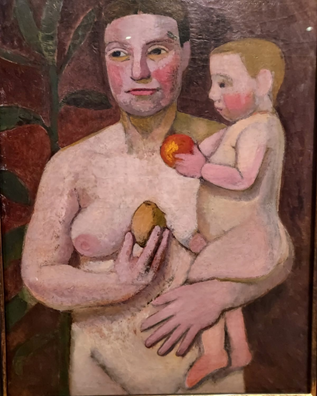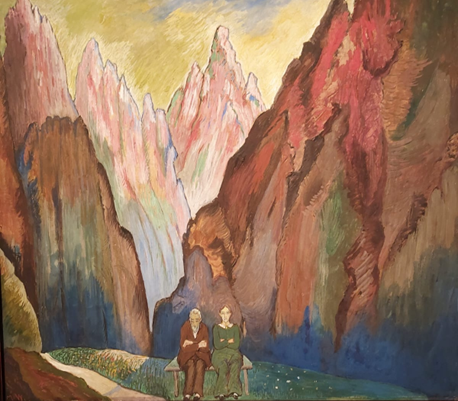At the start of the 20th century, women were still not allowed to go to official art schools. This exhibition shows how women artists, mostly based in Germany, made significant contributions to the development of modernism in art. Most people have heard of male artists like Picasso and Cezanne (currently on display at the Tate Modern) who pioneered the trend away from purely naturalistic depictions of reality.

Influenced by the new thinking of Freud on the sub-conscious and the development of photography and non-Western artistic forms, artists developed a new way of looking at the world. Cubism attempted to depict multiple dimensions while breaking down perspective conventions. Impressionists got out of the studio and used new ways to paint with brushes to show how light and nature looked. Expressionism was the next radical movement away from strictly representational art. Using strong colours and bold lines, it put heightened inner emotions on the canvas. The women in this exhibition embraced this new way of creating.
They were not just involved in changing how art was made. Unlike male artists, the very fact of becoming an artist was much more of a radical act, even if these artists came from middle- and upper-class backgrounds. The portrait above of Anna Rosland captures this radical, personal stance, with the woman confidently smoking a pipe, which is usually a male habit. Excluded from the academy, these women learned their craft through private lessons and classes at Ladies Academies, which were art schools established by the Association of Women Artists. Rural artist colonies, which were scattered around Europe, also provided support. Travelling to artistic hotbeds like Paris, which gave women more access to art, also helped.
Exhibitions of male artists often have a side focus on their female models, or “muses.” Women are defined in terms of physical or spiritual beauty, which is there to inspire the men. On the other hand, here are several pictures that include famous male artists of the time like Paul Klee or Kandinsky. You see what looks like a vigorous discussion between one of the woman artists, Emma Bossi, and Kandinsky (in shorts or underwear?) at the breakfast table.
These artists were living through the first feminist wave of struggle for the right to vote and were questioning family and notions of motherhood. As women, they were close to the lived, contradictory experience, and one room of the show is given over to their work showing mothers with children or children alone. The gaze is quite different from the prettiness and sentimentality of some Victorian painters. Children look back at you in a much more ambiguous, unnerving way.

Modersohn-Becker captures the joy, pride, and sensuality of the mother-child relationship—the opulent fruitfulness of it all. Flesh and warmth fill up the frame. Femininity is ablaze—a feel-good picture.
However, in the same room, there is the dark reality of a Käthe Kollwitz print that shows a dead woman. Kollwitz is the one artist I knew about before this exhibition because of her prints of Karl Liebknecht’s funeral and the fact she was a committed socialist. Indeed, the reason she switched mainly to prints was because she wanted her art to reach beyond the cultural elite. She was married to a doctor who worked in a working class area. At that time, death was more common in such communities, particularly for women in childbirth. She must have observed it regularly, and this print captures that brutality. There is another searing picture in the exhibition of a mother holding her dead child; it is difficult to make out her facial features as she seems to seep into the child’s dead body.

Kollwitz was also able to portray love and passion. She had a love affair and expressed it wonderfully in this print.

Along with Kollwitz’s prints, the work of Marianne von Werefkin is the highlight of the show. Born in Russia to a pro-Tsarist military father, she was part of the elite, and her father allowed her to study with Ilya Repin, a renowned Russian realist painter. Her exposure to international art through her links to the intelligentsia in St. Petersburg led her to move away from the limits of Repin’s art. At the age of 28 she told her father:
“she had never had any of the obsessions of the young society ladies’ and was not afraid to be judged by society
page 108, exhibition catalogue
She married another artist, Alexei Jawlensky, and they later moved to Munich, where, surprisingly, they stopped painting to help promote her husband’s career. Their home became a hub for artists and intellectuals. Such groups were a motor in the development of modernism. She herself wrote a book called Letters to an Unknown, published posthumously in 1960, which has many reflections on aesthetics and social expectations. Later, von Werefkin moved her household to Ascona, a small Swiss-Italian town on Lake Maggiore. After splitting with her husband, she continued to be a driving force in the art world, establishing an art museum in the town and a new art group called the Great Bear. She supported many younger artists. Her pictures of the local community and landscapes are full of colour, intense light, and dizzying perspectives.

This picture is particularly poignant. The bright light and sun behind the old couple are a reflection on growing old. If you look closely, the expressions on the man and woman are different. The man seems relaxed, half-dozing, and somehow more content than the woman, whose face seems more unhappy and even resentful. Is it some sort of comment on her time with Jawlensky? Who knows? The composition and colours work brilliantly, with the dark blues taking us down towards the depths of death.
Apart from these four key artists, other women artists from the period also have cameos in the show: Ottile Reylander, Jacoba van Heemskerck, and Emma Bossi. Bossi has a wonderful portrait of von Werefkin. Heemskerck contributes the only really abstract pictures to the show. Reylander, there is a picture of a naked teenage girl with an unsettling look that stays with you. Indeed, it is so ambiguous that the picture is not available as an image on the internet.
Over the last decade, there have been more and more shows and books that are reconstructing a history of art that includes women, black, Asian, and non-European people. Work that was always out there is being revealed. This can only be a good thing.
If you want to investigate further, you can treat yourself or buy somebody the superb new book by Katy Hessel entitled The Story of Art without Men.

Making Modernism: Paula Modersohn-Becker, Käthe Kollwitz, Gabriele Münter and Marianne Werefkin
Art Book Review Books Campism Capitalism China Climate Emergency Conservative Government Conservative Party COVID-19 Creeping Fascism Economics EcoSocialism Elections Europe Far-Right Fascism Film Film Review Fourth International France Gaza History Imperialism Iran Israel Italy Keir Starmer Labour Party Long Read Marxism Marxist Theory Migrants Palestine pandemic Police Protest Russia Solidarity Statement Trade Unionism Trans*Mission Ukraine United States of America War


I have just seen that the RA website has an article by the novelist Rachel Cusk on this exhibition.
https://www.royalacademy.org.uk/article/ra-magazine-rachel-cusk-modernism-women-artists